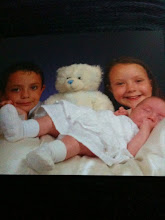A lazy post today. . Very tired Mummy here. Hope got up at 3:30am and pretty much stayed up from then on until it was official rise and time time 7:30 in the Matthews household.
Hope has made up for it and been quite sleepy all day. She's asleep now. Chris has gone fishing. Jordan and Max are in the garden kicking a ball whilst they wait for their truffle mixture to 'solidify'. I just know these chocolate truffles are going to be far to nice for me to resist .
So for those of you who don't know, this is what infantile spasms are (courtesy of the Internet ):
Infantile spasms are a type of epilepsy with a characteristic age of onset (typical age when seizures start), pattern of seizures and electroencephalogram (EEG). This means that it is an ‘electroclinical epileptic syndrome’.
They can also be called ‘salaam spasms’, because the appearance of the seizures is like a bowing forwards or backwards movement, or ‘West syndrome’ after Dr West who first described the condition in his own four month old son in 1841.
This type of epilepsy occurs in about one in 3000 children. Every year in the UK about 350-400 children will develop West syndrome
Symptoms
In nine out of 10 children with the condition, infantile spasms occur in the first year of life, typically between three and eight months old. Often, to begin with, the attacks are brief, infrequent and not typical of the syndrome, so it is quite common for the diagnosis to be made late. Frequently, because of the pattern of attacks and the cry that a child gives during or after an attack, they are initially thought to be colic.
The typical pattern is of a sudden flexion (bending forward) in a tonic (stiffening) fashion of the body, arms and legs. Sometimes, however, the episodes are extensor (arching). Usually, they are symmetrical (affecting both sides equally) but sometimes one side is affected more than the other.
Typically, each episode lasts just one or two seconds, there is then a pause for a few seconds followed by a further spasm. While single spasms may happen, infantile spasms usually happen in ‘runs’ or ‘clusters’ of several in a row.
It is common for babies who have infantile spasms to become irritable and for their development to slow up or even to go backwards until the spasms are controlled. These infants can also behave as if they cannot see, but this improves once the spasms are controlled and the EEG has improved.
Diagnosis
The diagnosis of infantile spasms is made by a combination of the typical features with a typical EEG. The EEG shows a very disorganised pattern termed ‘hypsarrhythmia’. The EEG is always abnormal in children with West syndrome but sometimes this abnormality is seen only during sleep.
Infantile spasms, like many other ‘electroclinical syndromes’, have lots of different causes. A particular cause will be found in seven or eight children out of every 10 children with West syndrome.
Most children with infantile spasms will need a number of tests (EEG, brain scans, blood tests, urine tests and, sometimes, spinal fluid and other tests) in order to try to identify the underlying cause.
Treatment
The main treatments used are steroids or vigabatrin (Sabril), Nitrazepam and sodium valproate (Epilim), may also be used. The type of steroids used are prednisolone or tetracosactide. Steroids must be used carefully as this treatment may cause some unpleasant side effects.
Prognosis (outlook)
In some children, infantile spasms respond easily to treatment, whereas in others they remain very resistant. Most children unfortunately go on to have other kinds of seizures in later childhood including an epilepsy syndrome called the Lennox-Gastaut syndrome. Most children also have learning difficulties. The prognosis for infantile spasms in both these respects is largely dependent on the underlying cause of the condition.
Hope is now on 4mls of vigabatrin twice daily. We've had to increase the dose gradually. Despite now being on almost her full dose she had over 60 yesterday :0(. But I also noted (yes literally noted- have to keep record of seizures, behaviour etc) that hope was really with it; her eyes seemed to be working. Turning to sounds. Smiling and laughing and chatty, looking at toys, sitting up with support - probably the nest she's ever been developmentally.
Earlier today I almost allowed allowed myself to believe that we might have a seizure free day. It got to 2:20pm before they struck. But then they really struck. 19 of the evil things all in one cluster. It's now just gone 6 and touch wood there haven't been anymore yet. But, hope hasn't even smiled yet today. I can see her eyes aren't working well again and I wonder what's going on in my lil girl's brain. :0(
Roll on bedtime. Only another 5 hours to go xxx




























































